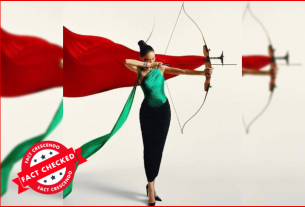People are often interested in the origins and evolution of various traditions. However, social media posts on these subjects can sometimes be misleading. It is important to approach such information critically and seek out reliable sources to ensure accuracy and depth of understanding.
Social Media Posts
A recent viral social media post draws attention to a fascinating historical connection, indirectly implying that the modern graduation gown resembles the traditional Abaya, a sign of modesty and dignity worn by many Muslim women.
The accompanying viral video on social media circles highlights the influence of medieval Arab universities, specifically the University of al-Qarawiyyin, founded by Fatima al-Fihriya, on the evolution of the graduation gown. It also mentions renowned scholars like Ibn Rushd, who wore traditional attire called a Throbe and suggests that European students adopted this dress, leading to the graduation gown tradition.
While the video contains several information in line with most accepted beliefs and historical evidence, the caption circulating on social media is somewhat misleading. Let’s clarify these points:
Explanation
The Historical Facts:
University of al-Qarawiyyin:
Founded in 859 AD in Fez, Morocco, by Fatima al-Fihriya, the University of al-Qarawiyyin (University Kairaouine) has a long and prestigious history as a center for Islamic education and scholarships and is considered the world’s oldest continually operating educational institution, according to the Guinness World Records.
Al-Qarawiyyan University alumni include famous personalities like Ibn Rushd (Averreos), Hassan al-Wazzan (Leo Africanus), Jewish philosopher Moses bin Maimon (Maimonides), Dutch orientalist Jacob van Gool + Gerbert de Aurillac (Pope 999-1003 who introduced Arabic numerals to Europe).
This university played a significant role in the intellectual life of the medieval Islamic world and attracted scholars from various regions. More details can be read here.
Influence on European Education:
During the medieval period, European scholars traveled to Islamic universities, including al-Qarawiyyin, to study a range of subjects. This cultural exchange significantly influenced the European education systems, and the University of Bologna, Italy, was founded in 1088 and is considered the oldest in Europe.
The academic attire, including robes and caps, worn by these scholars was adapted into European academic traditions. More details can be read here and here.
Traditional Attire: Thobe vs. Abaya:
The Thobe (also spelled Throbe or Thawb) is a long robe whose origins can be traced back to ancient Arabia when it was worn as a simple, lightweight garment for protection against the elements.
In pre-Islamic Arabia, the thobe was worn by both men and women and was made from lightweight materials such as linen or cotton. During the Islamic Golden Age, the thobe became more ornate and was made from more luxurious materials such as silk. It was also worn by scholars and intellectuals, who used long sleeves and high collars to protect themselves from the sun while they studied and wrote.
It symbolizes cultural heritage and is often associated with scholarly and formal contexts. More on this here.
The Abaya, on the other hand, is a long, flowing cloak worn by women in various Muslim countries as a sign of modesty.
Clarifying the Misleading Caption:
The viral social media post incorrectly associates the modern graduation gown with the female Abaya. In reality, the historical roots of the graduation gown are more closely aligned with the Thobe worn by male scholars in medieval Arab universities. The resemblance lies in the long, flowing robes that were part of the academic attire for scholars, which European students adopted and adapted over time.
The graduation gown, known as the subfusc, includes a flat hat with a tassel, also called the mortar board. In this speech, a graduate dwells on Islamic civilization’s massive influence on the graduation gown.
Follow us and stay up to date with our latest fact checks.
Facebook | Twitter | Instagram | Google News | TikTok
Conclusion:
The contribution of medieval Arab universities to the evolution of the graduation gown is indeed significant. The oldest continually operating educational institution, the University of al-Qarawiyyin, and scholars like Ibn Rushd exemplify the rich intellectual heritage that influenced European academic traditions.
However, it’s important to represent these historical connections accurately. The graduation gown’s design is closely related to a dress called a Thobe, worn by both males and females, rather than the female Abaya.
Ensuring factual accuracy helps appreciate the historical influences and cultural exchanges that shaped modern academic customs.

Title: The Influence of Medieval Arab Universities on Modern Graduation Gowns
Fact Check By: Fact Crescendo TeamResult: Insight






